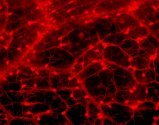
COBRE
Department of Ophthalmology
University of Oklahoma Health Sciences Center
HOME | PI | PJIs | CORES | MENTORS | IAC | EAC | SPOTLIGHT | SEMINARS | CALENDAR | AFFILIATES
John Ash, Ph.D.
Wei Cao, Ph.D.
Michael Ihnat, Ph.D.
Yun Le, Ph.D.
Raju Rajala, Ph.D.
PROMISING JUNIOR INVESTIGATOR
MICHAEL IHNAT, PH.D.
COBRE Research Project
MICHAEL IHNAT, PH.D.
COBRE Research Project
HIF-1 as a Therapeutic Target in Diabetic Retinopathy
(Mentor, Muna I. Naash, PhD, Co-mentor, Eric Howard, PhD)
Diabetic retinopathy is a major complication of diabetes and a leading cause of blindness. In its later stages this disease is characterized by a hyperproliferation of retinal blood vessels, or angiogenesis. Hypoxia inducible factor -1 (HIF-1) is a transcription factor that is rapidly induced in response to hypoxia and regulates the expression of several genes critical to angiogenesis and glucose regulation. HIF-1 has been shown to be significantly increased in the retina in response to hypoxia and to advanced glycation products (AGEs), altered macromolecules associated with diabetes. The overall hypothesis driving these studies is that inhibition of angiogenesis through the specific disruption of HIF-1 is a novel, early target for potentially controlling proliferative retinopathy. The goal of specific aim one is to target HIF-1alpha, a critical subunit of HIF-1, at the messenger RNA level through the use of ribozymes, or catalytic pieces of RNA. The goal of specific aim two is to find specific peptide inhibitors of the interaction between the HIF-1alpha and the HIF-1beta (ARNT) subunit using phage peptide display. Both the ribozymes and the peptides will be introduced locally into the retina using adenovirus. The effect of these agents on angiogenesis and on downstream targets of HIF-1 (VEGF, PAI-1) will be examined using an oxygen-induced mouse ischemia model. Using these molecular approaches we seek to define a role for HIF-1 in proliferative diabetic retinopathy and to determine whether this transcription factor represents a valid target for therapy in this disease state.
Please send comments,
questions, or error reports to Holly-Whiteside@ouhsc.edu

Copyright © 2003 The Board of Regents of the University of Oklahoma, All Rights Reserved
University of Oklahoma Disclaimers
Copyright © 2003 The Board of Regents of the University of Oklahoma, All Rights Reserved
University of Oklahoma Disclaimers